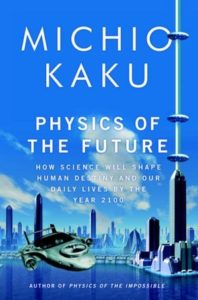BOOK REVIEW
By Katherine A. Carroll, NTP
 Physics of the Future, How Science Will Shape Human Destiny And Our Daily Lives By The Year 2100 by Machio Kaku (ISBN 978-0-307-47333-2; Anchor Books, 2011; www.anchorbooks.com, paperback, 450 pages; $15.95)
Physics of the Future, How Science Will Shape Human Destiny And Our Daily Lives By The Year 2100 by Machio Kaku (ISBN 978-0-307-47333-2; Anchor Books, 2011; www.anchorbooks.com, paperback, 450 pages; $15.95)
Physics of the Future by Michio Kaku is a visionary book described by the Wall Street Journal as, “A fascinating wide-ranging tour of what to expect from technological progress over the next century.” While much of Machio Kaku’s writing encompasses topics outside the realm of health freedom, embracing his well-researched vision that is unfolding today in labs all across the World, requires an expanded definition of what health freedom is and how to protect it and yourself.
Michio Kaku is a professor of theoretical physics at the City University of New York, a cofounder of string-field theory, the bestselling author of half a dozen widely acclaimed science books, and he has his own science TV show as well as hosting two radio programs broadcasting to over 140 radio stations.
As we stand at the precipice of a World where all surfaces are “smart” (embedded with chips) and interactive in an “augmented reality,” he presents concepts that will bring new fields into existence, creating jobs globally while raising ethical questions. Kaku admits, “This, however, raises another question – the sensitive question of privacy, which will be one of the great controversies of the future.”
Biotechnology, artificial intelligence, nanotechnology, and telecommunications are being transformed by thousands of scientists. Kaku says, “Since we are drowning in an ocean of information, the most precious commodity in modern society is wisdom.” This is never truer than for health-freedom fighters today.
We have some major decisions to make as a race right now. Imagine the implications of a loss of privacy, control, and forfeiting more health freedom in light of our clothing uploading our bio-statistics as we dress in the morning or having internal robots cleaning our bloodstream, performing surgeries, zapping cancer cells, or delivering medications directly to the target site while being driven in a nanocar controlled remotely by a technician? Or selecting genes for our children or enhancing our own genes to make ourselves smarter or bionic in strength – even merging with robots to use their technology and mechanics inside our bodies?
Cochlear implants and artificial retinas are here; this technology is in use now. Rodney Brooks says, “Fifty years from now we can expect to see radical alterations of human bodies through genetic modification. (Merging with robots adding electronic enhancements) The human menagerie will expand in ways unimaginable to us today….” The real danger comes not so much from consumer demand but from dictatorial governments that may want to use genetic engineering for their own purposes, such as breeding stronger but more obedient soldiers.
With computer power doubling every 18 months (Moore’s Law), changes rising from research and development will be implemented at an increasingly fast pace. We will live in a World of mixed reality – both the virtual and the real. The time to think of the implications of implementing these astounding scientific breakthroughs in the context of health freedom is now – and with a great deal of common sense.
Kaku states, “Common sense will be the currency of the future.” Robots are proliferating and will take over many jobs. The Da Vinci Robot has already performed over 48,000 surgeries in 2006 alone in over 800 hospitals in Europe, North, and South America. Some European nations find themselves short on children; robots are being created to perform caretaking tasks for the elderly. “In the past people said the pen was mightier than the sword. In the future, it will be the chip that is mightier than the sword.”
Importantly, he adds, “[a]ll the technological revolutions described here are leading to a single point: the creation of a planetary civilization. This transition is perhaps the greatest in human history.”
Other issues that will rise are even more crucial, “The holy grail of nanotechnology is to create the molecular assembler, or replicator, but once it is invented it could alter the very foundation of society itself.” When robots have the ability to replicate themselves and outpace our intelligence, we truly have crossed a line where human life as we know it may never be recovered. It is something Kaku deals with extensively; and he cites those scientists who, when debating this issue, don’t say if, but when this momentous event will happen.
Resurrecting an extinct animal or Neanderthal is possible but will raise ethical worries. Klein of Stanford says, “Are you going to put them in Harvard or the zoo?” Webb Miller and Stephan C. Schuster of Pennsylvania State University have extracted 3 billion base pairs of DNA from the frozen carcasses of the woolly mammoths. “A year ago, I would have said that this is science fiction. But now with so much of the mammoth genome sequenced, resurrecting them is no longer out of the question.”
The health-freedom community needs to lead the march into the future adoption of inventions, requiring wisdom and forethought about the implications of their adoption:
- All surfaces have intelligence, chips are “smart,” and able to communicate.
- We wear contact lenses that give full-time access to the internet and 3-D imagery.
- Our clothing is “smart,” calling for an ambulance in the event of an emergency, providing GPS coordinates, and uploading medical history.
- We have personal MRI scanners uploading to wall-screen computers. Our internal organs appear in 3-D on the screen, which interacts as a doctor, accessing and diagnosing.
- “While washing your face, hundreds of hidden DNA and protein sensors in the mirror, toilet, and sink silently spring into action, analyzing the molecules you emit in your breath and bodily fluids, checking for the slightest hint of any disease at the molecular level.”
- Nanotechnology allows us to grow new organs as they wear out or become diseased via tissue engineering, stem cells, and even to reverse aging.
- A laser scan of our iris, accompanied by facial recognition, is the new identification.
- Swarm bots will fly to the scene of disasters, conducting reconnaissance and surveillance.
- Surgery is replaced by molecular machines moving through the bloodstream, guided by magnets.
- Nanotechnology detects cancer colonies years before they can form a tumor.
- Robotic surgeons, cooks, and caretakers are common.
- By the end of the Century our zoos are populated with animals extinct for thousands of years.
- Human cloning is completely possible. Regrowth of human limbs is underway. “The U.S. Army has made it a priority to find a way to grow back limbs.”
- Everyone has their personalized genome available on CD-ROM.
- Parents, children, sports teams, etc. will have their own geneticist to enhance, strengthen, or add longevity to gene expression.
- Biotechnology introduces grains such as “super-rice” that are engineered to thrive in hostile environments.
“Science is a double-edged sword; it creates as many problems as it solves, but always on a higher level.” We need wisdom, discernment, and common sense to sort the beneficial from the controlling, damaging, and destructive inventions. What will health freedom look like in the future? How much transparency is too much? Where do we let God be God/Nature determine, etc. and where do we intervene? These are all critical questions that are evoked by Kaku’s insightful work. We would do well to start answering them soon.

No Comments Yet